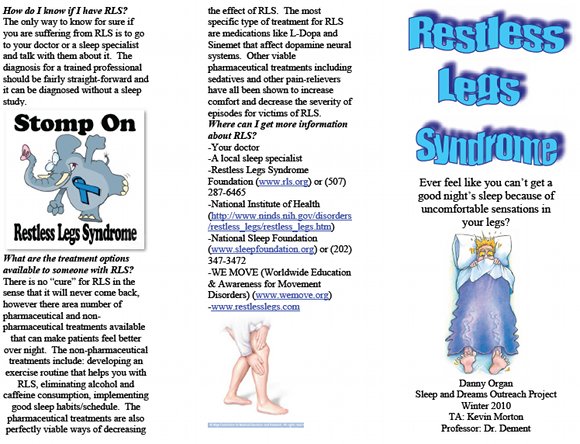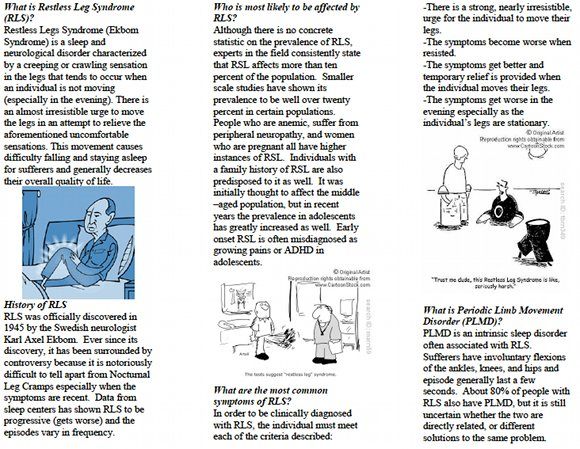
| Connect & Subscribe |
Restless Legs Syndrome Brochure
Ever feel like you can't get a good night's sleep because of uncomfortable sensations in your legs?
An Outreach Project by Danny Organ | Return To Outreach Projects 2010
The following is a brochure created for Stanford Sleep and Dreams. If it is difficult to read using the images, you may view the full text here.
Also feel free to download this brochure for distributional or general information purposes. Please refer to our privacy policy for our relevant disclaimers.


What is Restless Leg Syndrome (RLS)?
Restless Legs Syndrome (Ekbom Syndrome) is a sleep and neurological disorder characterized by a creeping or crawling sensation in the legs that tends to occur when an individual is not moving (especially in the evening). There is an almost irresistible urge to move the legs in an attempt to relieve the aforementioned uncomfortable sensations. This movement causes difficulty falling and staying asleep for sufferers and generally decreases their overall quality of life.
History of RLS
RLS was officially discovered in 1945 by the Swedish neurologist Karl Axel Ekbom. Ever since its discovery, it has been surrounded by controversy because it is notoriously difficult to tell apart from Nocturnal Leg Cramps especially when the symptoms are recent. Data from sleep centers has shown RLS to be progressive (gets worse) and the episodes vary in frequency.
Who is most likely to be affected by RLS?
Although there is no concrete statistic on the prevalence of RLS, experts in the field consistently state that RSL affects more than ten percent of the population. Smaller scale studies have shown its prevalence to be well over twenty percent in certain populations. People who are anemic, suffer from peripheral neuropathy, and women who are pregnant all have higher instances of RSL. Individuals with a family history of RSL are also predisposed to it as well. It was initially thought to affect the middle aged population, but in recent years the prevalence in adolescents has greatly increased as well. Early onset RSL is often misdiagnosed as growing pains or ADHD in adolescents.
What are the most common symptoms of RLS?
In order to be clinically diagnosed with RLS, the individual must meet each of the criteria described:
What is Periodic Limb Movement Disorder (PLMD)?
PLMD is an intrinsic sleep disorder often associated with RLS. Sufferers have involuntary flexions of the ankles, knees, and hips and episode generally last a few seconds. About 80% of people with RLS also have PLMD, but it is still uncertain whether the two are directly related, or different solutions to the same problem.
How do I know if I have RLS?
The only way to know for sure if you are suffering from RLS is to go to your doctor or a sleep specialist and talk with them about it. The diagnosis for a trained professional should be fairly straight-forward and it can be diagnosed without a sleep study.
What are the treatment options available to someone with RLS?
There is no "cure" for RLS in the sense that it will never come back, however there area number of pharmaceutical and non-pharmaceutical treatments available that can make patients feel better over night. The non-pharmaceutical treatments include: developing an exercise routine that helps you with RLS, eliminating alcohol and caffeine consumption, implementing good sleep habits/schedule. The pharmaceutical treatments are also perfectly viable ways of decreasing the effect of RLS. The most specific type of treatment for RLS are medications like L-Dopa and Sinemet that affect dopamine neural systems. Other viable pharmaceutical treatments including sedatives and other pain-relievers have all been shown to increase comfort and decrease the severity of episodes for victims of RLS.
Where can I get more information about RLS?
-Your doctor
About This Site
Welcome! This site is continuously being created by students of Dr. William C. Dement's Sleep And Dreams course at Stanford University.
We made this site as a call to action for people all over the world to live healthier, happier, safer, and more productive lives by learning about their own sleep. We have faith that reading the information provided on this site will motivate you to be smart about your sleep deprivation and strategic about your alertness in order to live life to your fullest, most energetic potential.
In fact, we challenge you to do so! What do you say, are you up for the challenge?
Interviews With Sleep Specialists: Insights Into the Worlds of Sleep Medicine & Sleep Business
America's Most Dangerous Disorder: What Is Sleep Apnea Doing To Your Sleep?
Sleep Debt: How Much More Will You Achieve When You Reduce Yours?
The Stages Of Sleep: The Journey Through The Night
Delayed Sleep Phase: You Want To Sleep But You're Not Tired Yet
Paralyzed at Night: Is Sleep Paralysis Normal?
Sleep In Words: Smart, Strange, and Funny Quotes About Sleep
Sleep Disorders In Children: What's Keeping Your Child From A Full Night's Rest?
Attacks of Pavor Nocturnus (a.k.a. Sleep Terrors, Night Terrors, or Incubus Attacks)
The Stanford Sleep Book
Dr. Dement's pioneering textbook has been the core text for Sleep and Dreams since 1980, but it has just recently been made available to the wider public for the first time.
In it you'll find a more detailed account of the most important things you need to know about sleep, alertness, dreams, and sleep disorders. Studies, statistics, plus plenty of Dr. Dement's classic anecdotes painting the history of sleep medicine.
Preface | Intro | Contents | Get A Copy
More Sleep Resources
The Zeo
A revolution in personal sleep tracking, the Zeo is a wireless headband that transmits your brainwaves in realtime to a dock (pictured here) or your smartphone. The result? You can wake up and see exactly what stages of sleep you were in during the night! Unprecedented personalized sleep knowledge.
Sleep Paralysis: A Dreamer's Guide
Ever woken up paralyzed? A surprising number of us have, believe it or not. But few know the actual causes of this phenomenon, and fewer still how to exert control over it. Dream researcher and sleep paralysis expert Ryan Hurd shares breakthrough insights into how to do just that.
Important Disclaimer
Please Note:
The information found on this page and throughout this site is intended for general information purposes only. While it may prove useful and empowering, it is NOT intended as a substitute for the expertise and judgments of healthcare practitioners.
For more info, see our
Terms of Use.









